
Rhododendron occidentale, the western azalea or California azalea, is one of two deciduous Rhododendron species native to western North America. The western azalea is known to occur as far north as Lincoln and Douglas Counties in Oregon and as far south as the mountains of San Diego county. Typically found in the coastal ranges of western North America, it also grows in the Cascade and Sierra Nevada mountain ranges, but is not known east of them.

Vaccinium uliginosum is a Eurasian and North American flowering plant in the genus Vaccinium within the heath family.

Phaeolus schweinitzii, commonly known as velvet-top fungus, dyer's polypore, dyer's mazegill, or pine dye polypore, is a fungal plant pathogen that causes butt rot on conifers such as Douglas-fir, spruce, fir, hemlock, pine, and larch. P. schweinitzii is a polypore, although unlike bracket fungi the fruiting body may appear terrestrial when growing from the roots or base of the host tree.
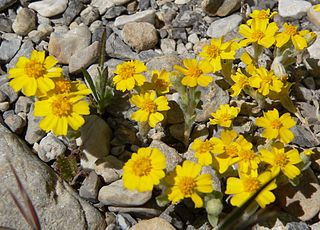
Eriophyllum wallacei is a North American flowering plant in the family Asteraceae known by the common names woolly daisy and woolly easterbonnets. It grows in the southwestern United States and northwestern Mexico. It may grow in clumps or on short erect stems in sand, rocks, and gravel.
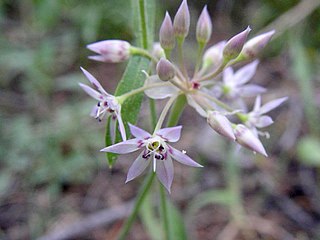
Allium campanulatum is a species of wild onion known by the common name dusky onion or Sierra onion. This is a flowering plant native to the western United States from southeastern Washington and northern Oregon to southern California, and western Nevada. The dusky onion grows in foothills and mountains, especially in dry areas, such as chaparral habitats.
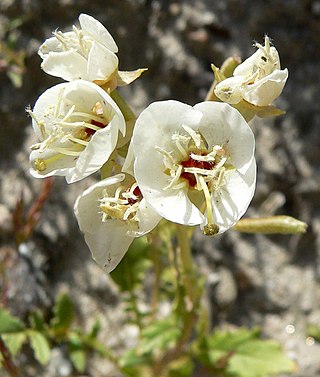
Chylismia claviformis is a species of wildflower known as browneyes or brown-eyed primrose native to North America. This species is found across western North America from the Pacific Northwest to northern Mexico.

Cirsium occidentale, with the common name cobweb thistle or cobwebby thistle, is a North American species of thistle in the family Asteraceae.
Andersonglossum occidentale is a species of flowering plant in the borage family known by the common name western hound's tongue.

Eriophyllum confertiflorum, commonly called golden yarrow or yellow yarrow, is a North American species of plant in the family Asteraceae, native to California and Baja California. It has wooly leaves when young, and yellow flower heads. "Eriophyllum" means "wooly leaved."

Anthoxanthum occidentale is a species of grass known by the common name California sweetgrass. It is a close relative of the more widely known sweet grass. It is native to the west coast of the United States from Washington to California, where it grows in the coniferous forests of the coastal mountain ranges. This is a rhizomatous perennial grass with leaves up to 30 centimeters long and 1.5 wide. The stem reaches a meter in height with an inflorescence of 7 to 10 centimeters. The spikelets grow on short, wavy stalks and each has three florets with long, protruding stamens during flowering.

Hydrophyllum occidentale is a species of flowering plant in the waterleaf family known by the common name western waterleaf.
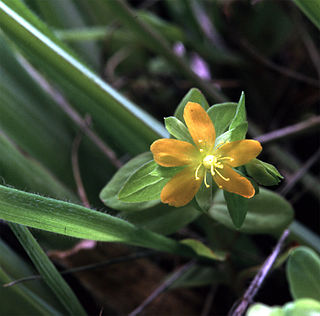
Hypericum anagalloides is a species of flowering plant in the St. John's wort family Hypericaceae. It is known by the common names creeping St. John's-wort, tinker's penny and bog St. John's-wort.

Hypochaeris glabra is a species of flowering plant in the tribe Cichorieae within the family Asteraceae known by the common name smooth cat's ear. It is native to Europe, North Africa, and the Middle East but it can be found on other continents where it is an introduced species and a widespread weed. It has become widespread in Africa, southern and southeastern Asia, Australia, and parts of the Americas.
Enemion stipitatum is a species of flowering plant in the buttercup family known by the common name Siskiyou false rue anemone. It is native to northern California and southern Oregon where it grows in forest, woodland, and chaparral habitats in the local mountain ranges. This is a petite perennial herb producing one or more erect, unbranched stems to a maximum height no more than 15 centimeters. Leaves appear toward the top of each stem in arrays of several cloverlike leaves with three-lobed leaflets. The tiny solitary flowers each have five white petallike sepals only a few millimeters long. The center of the flower contains several thick white stamens topped with small yellow anthers and 3 to 5 styles.
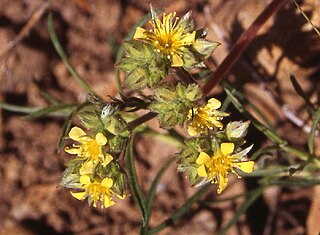
Ivesia aperta is a species of flowering plant in the rose family known by the common name Sierra Valley mousetail.

Enemion are spring ephemerals with white flowers, branching stems, and finely divided leaves in the buttercup family. One species, Enemion biternatum, is native to eastern and central North America, while Enemion occidentale, stipitatum, hallii, and savilei are native to the West Coast of the United States and Canada. The genus Isopyrum is similar, and has species native to Europe and Asia.

Allium cratericola is a species of wild onion known by the common name Cascade onion. It is endemic to California, where is an uncommon member of the flora in several of the state's mountain ranges, including the northern and southern California Coast Ranges, the western Transverse Ranges, Klamath Mountains, and the Sierra Nevada foothills. Its range covers much of the state, from Riverside County to Siskiyou County.
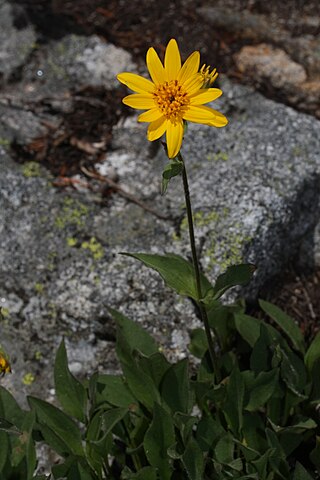
Arnica mollis is a North American species of arnica in the sunflower family, known by the common name soft arnica, or hairy arnica. It is native to Canada and the United States (Alaska and the western mountains as far south as San Bernardino County, California and Rio Arriba County, New Mexico. There are also isolated populations in the White Mountains of Coos County, New Hampshire. The species grows in subalpine mountain habitat such as meadows and streambanks.

Lilium occidentale is a rare North American species of lily known by the common name western lily. Its species name 'Occidentale' means 'westernmost' and refers to its location along the West Coast. It is native to northwestern California and southwestern Oregon. It grows in coastal prairie habitat, swamps and stagnant bogs with Drosera species, bluffs and sandy cliffs, and seaside spruce forests. This rare wildflower is limited in distribution and directly endangered by a number of environmental factors. It is a federally listed endangered species and it is listed as endangered by the states of California and Oregon.

Polemonium occidentale is a species of flowering plant in the phlox family known by the common names western polemonium and western Jacob's-ladder. There are two subspecies. The common ssp. occidentale is native to western North America from British Columbia to Colorado to California, where it can be found in moist areas of many habitat types, including meadows and woodlands. There is also a rare subspecies, ssp. lacustre, which is known only from a total of three counties in Minnesota and Wisconsin, and is found only in white cedar swamp habitat there.


















